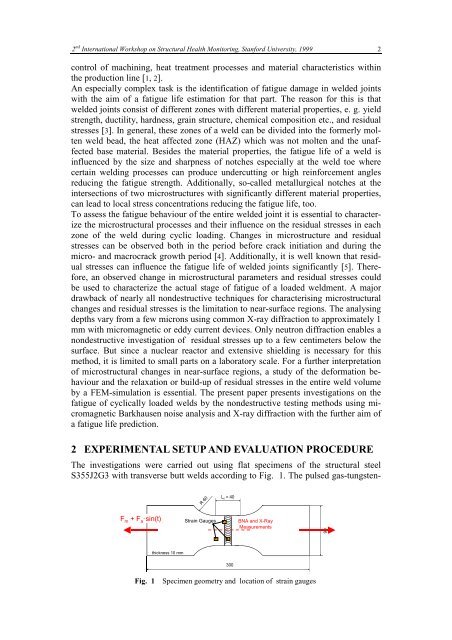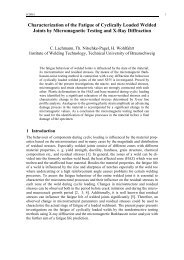nondestructive characterization of fatigue processes in cyclically ...
nondestructive characterization of fatigue processes in cyclically ...
nondestructive characterization of fatigue processes in cyclically ...
Create successful ePaper yourself
Turn your PDF publications into a flip-book with our unique Google optimized e-Paper software.
2 nd International Workshop on Structural Health Monitor<strong>in</strong>g, Stanford University, 1999 2<br />
control <strong>of</strong> mach<strong>in</strong><strong>in</strong>g, heat treatment <strong>processes</strong> and material characteristics with<strong>in</strong><br />
the production l<strong>in</strong>e [1, 2].<br />
An especially complex task is the identification <strong>of</strong> <strong>fatigue</strong> damage <strong>in</strong> welded jo<strong>in</strong>ts<br />
with the aim <strong>of</strong> a <strong>fatigue</strong> life estimation for that part. The reason for this is that<br />
welded jo<strong>in</strong>ts consist <strong>of</strong> different zones with different material properties, e. g. yield<br />
strength, ductility, hardness, gra<strong>in</strong> structure, chemical composition etc., and residual<br />
stresses [3]. In general, these zones <strong>of</strong> a weld can be divided <strong>in</strong>to the formerly molten<br />
weld bead, the heat affected zone (HAZ) which was not molten and the unaffected<br />
base material. Besides the material properties, the <strong>fatigue</strong> life <strong>of</strong> a weld is<br />
<strong>in</strong>fluenced by the size and sharpness <strong>of</strong> notches especially at the weld toe where<br />
certa<strong>in</strong> weld<strong>in</strong>g <strong>processes</strong> can produce undercutt<strong>in</strong>g or high re<strong>in</strong>forcement angles<br />
reduc<strong>in</strong>g the <strong>fatigue</strong> strength. Additionally, so-called metallurgical notches at the<br />
<strong>in</strong>tersections <strong>of</strong> two microstructures with significantly different material properties,<br />
can lead to local stress concentrations reduc<strong>in</strong>g the <strong>fatigue</strong> life, too.<br />
To assess the <strong>fatigue</strong> behaviour <strong>of</strong> the entire welded jo<strong>in</strong>t it is essential to characterize<br />
the microstructural <strong>processes</strong> and their <strong>in</strong>fluence on the residual stresses <strong>in</strong> each<br />
zone <strong>of</strong> the weld dur<strong>in</strong>g cyclic load<strong>in</strong>g. Changes <strong>in</strong> microstructure and residual<br />
stresses can be observed both <strong>in</strong> the period before crack <strong>in</strong>itiation and dur<strong>in</strong>g the<br />
micro- and macrocrack growth period [4]. Additionally, it is well known that residual<br />
stresses can <strong>in</strong>fluence the <strong>fatigue</strong> life <strong>of</strong> welded jo<strong>in</strong>ts significantly [5]. Therefore,<br />
an observed change <strong>in</strong> microstructural parameters and residual stresses could<br />
be used to characterize the actual stage <strong>of</strong> <strong>fatigue</strong> <strong>of</strong> a loaded weldment. A major<br />
drawback <strong>of</strong> nearly all <strong>nondestructive</strong> techniques for characteris<strong>in</strong>g microstructural<br />
changes and residual stresses is the limitation to near-surface regions. The analys<strong>in</strong>g<br />
depths vary from a few microns us<strong>in</strong>g common X-ray diffraction to approximately 1<br />
mm with micromagnetic or eddy current devices. Only neutron diffraction enables a<br />
<strong>nondestructive</strong> <strong>in</strong>vestigation <strong>of</strong> residual stresses up to a few centimeters below the<br />
surface. But s<strong>in</strong>ce a nuclear reactor and extensive shield<strong>in</strong>g is necessary for this<br />
method, it is limited to small parts on a laboratory scale. For a further <strong>in</strong>terpretation<br />
<strong>of</strong> microstructural changes <strong>in</strong> near-surface regions, a study <strong>of</strong> the deformation behaviour<br />
and the relaxation or build-up <strong>of</strong> residual stresses <strong>in</strong> the entire weld volume<br />
by a FEM-simulation is essential. The present paper presents <strong>in</strong>vestigations on the<br />
<strong>fatigue</strong> <strong>of</strong> <strong>cyclically</strong> loaded welds by the <strong>nondestructive</strong> test<strong>in</strong>g methods us<strong>in</strong>g micromagnetic<br />
Barkhausen noise analysis and X-ray diffraction with the further aim <strong>of</strong><br />
a <strong>fatigue</strong> life prediction.<br />
2 EXPERIMENTAL SETUP AND EVALUATION PROCEDURE<br />
The <strong>in</strong>vestigations were carried out us<strong>in</strong>g flat specimens <strong>of</strong> the structural steel<br />
S355J2G3 with transverse butt welds accord<strong>in</strong>g to Fig. 1. The pulsed gas-tungsten-<br />
F m + F a·s<strong>in</strong>(t)<br />
Stra<strong>in</strong> Gauges<br />
BNA and X-Ray<br />
Measurements<br />
thickness 10 mm<br />
Fig. 1<br />
Specimen geometry and location <strong>of</strong> stra<strong>in</strong> gauges



